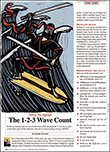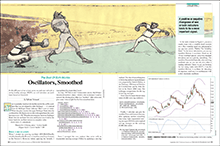LETTERS TO THE EDITOR
December 2013 Letters To The Editor
The editors of S&C invite readers to submit their opinions
and information on subjects relating to technical analysis and this magazine.
This column is our means of communication with our readers. Is there something
you would like to know more (or less) about? Tell us about it. Without a source
of new ideas and subjects coming from our readers, this magazine would not
exist.
Address your correspondence to: Editor, Stocks & Commodities,
4757 California Ave. SW, Seattle, WA 98116-4499, or E-mail to editor@traders.com.
All letters become the property of Technical Analysis, Inc. Letter-writers
must include their full name and address for verification. Letters may
be edited for length or clarity. The opinions expressed in this column do not
necessarily represent those of the magazine. —Editor
SELF-OPTIMIZATION OF INPUTS?
Editor,
I concur with your reader, Ronald Stuart, whose letter was published in the August 2013 issue. I, too, would like to see old strategies revisited (albeit with a modern computerized twist). I have been trading for 29 years, and have subscribed to S&C for two years now. I particularly enjoy the digital editions.
My current project is to place each strategy addressed in the Traders’ Tips section of your magazine each month on the same symbol and time frame (for example, symbol ANV placed on a 20-minute chart).
At the TradeStation forum, an inverse Fisher strategy is offered based on the May 2004 article in your magazine by John Ehlers (“The Inverse Fisher Transform”). I imported that strategy into TradeStation. I can even optimize the strategy inputs such as the buy line & sell line. I usually need to optimize the strategy inputs, as the backtesting and walk-forward trade analysis results did not appear very favorable. I open an additional workspace chart (same symbol, same time frame, which is a 20-minute chart) for each strategy from each month’s Traders’ Tips. I then optimize the inputs for each strategy.
Each strategy seems to have the same limitations: It will be profitable for a few days, then the inputs have to be reoptimized.
Then I read with great interest the article and related Traders’ Tips contributions for the self-adjusting RSI strategy as presented by David Sepiashvili in your February 2006 issue (“The Self-Adjusting RSI”).
I placed the self-adjusting RSI strategy on as 20-minute chart of ANV on July 24, 2013. It’s been running one week, and I can’t tell what I should be optimizing or even if I should be optimizing the length and/or K inputs. I see buy/sell short/cover on the chart.
What’s more, it seems to me that our computers should be able to optimize these inputs in real time on any given strategy. I read several technology magazines each month, and I am amazed at the amount of resources poured into predictive software and apps. For example, the Google Now app aims for “predictive intelligence,” offering assistance as users go about their day — from hailing a cab, to suggesting proper clothing (based on preferences and weather conditions), to local cuisine recommendations (based on previous consumptions), to timely reminders for personal grooming, and so on.
Real-time adaptive, automatic optimization of strategy inputs or self-adjusting strategy inputs could make great strides in placing the power of profitable trading in the hands of your readers.
P.S. What inputs should I be optimizing in the self-adjusting RSI strategy, or is it already set as a truly self-adjusting strategy?
Dave Sidwell
Thank you for your feedback. Regarding the self-adjusting RSI, it’s the overbought & oversold levels that are adjusted. The formulas provided in the article make these benchmarks self-adjust.
1-2-3 WAVE COUNT
 Editor,
Editor,
I read with interest Sylvain Vervoort’s article series beginning with the May 2013 issue of Stocks & Commodities (“Indicator Rules For Swing Trading Strategies, Part 1”). Regarding the 1-2-3 wave count (“The 1-2-3 Wave Count,” which was part 2 of Vervoort’s IRSTS series, June 2013 S&C), can this be applied to time frames lower than daily charts?
I was wondering if I can use it for intraday trading the emini S&P.
SSChiu
Author Sylvain Vervoort replies:
Depending of what the underlying instrument is and the time frame used, you will have to adapt the wave count settings.
For the most part, you can use this swing trading technique with any instrument or time frame, even on renko bars or ranges not related to time. But remember that the 1-2-3 wave count is just part of my system and not meant to be used alone to trade. I have outlined other components of my technique in my other articles in this series.
If you use wave counts on their own, you should run backtests first to make sure of the settings that tend to be profitable. I did some testing myself, and I generally found it to be profitable. However, using my complete set of rules (indicator rules for a swing trading strategy, or IRSTS) will help to avoid some of the losing trades, obtaining a better final result.
OSCILLATORS, SMOOTHED
 Editor,
Editor,
It was good to read “Oscillators, Smoothed” by Sylvain Vervoort in the September 2013 S&C. The article invokes rainbow charts, and I remember reading about them in S&C (“Rainbow Charts” by Mel Widner, July 1997 S&C).
I downloaded the SVEZLRBPercB indicator for NinjaTrader from Vervoort’s website, and I set the parameters to:
- PercentB deviation period: 18
- PercentB average: 3
- Stochastic period: 30
- Stochastic slowing: 3
At first, it appeared to work on the 60-minute chart, but I am not sure about my 240-minute chart. Can these settings be used in any time frame? Or would they need to be adjusted for my weekly, daily, 240-minute and 60-minute charts? If so, could Vervoort provide some guidance on what they should be?
Mario Fernandes
Author Sylvain Vervoort replies:
No rule of thumb. What I do is look at the chart and some minimum reversal that I would like to see as a wave. I adapt the settings for this reversal. Usually, I use both a percentage and an ATR influence. So I would use:
- 240-minute: 0.8,5,1.2
- Daily: 1.5,5,1.5
- Weekly: 3.8,5,4.5
Originally published in the December 2013 issue of Technical Analysis of Stocks & Commodities magazine. All rights reserved. © Copyright 2013, Technical Analysis, Inc.
Return to
Contents
 Editor,
Editor, Editor,
Editor,